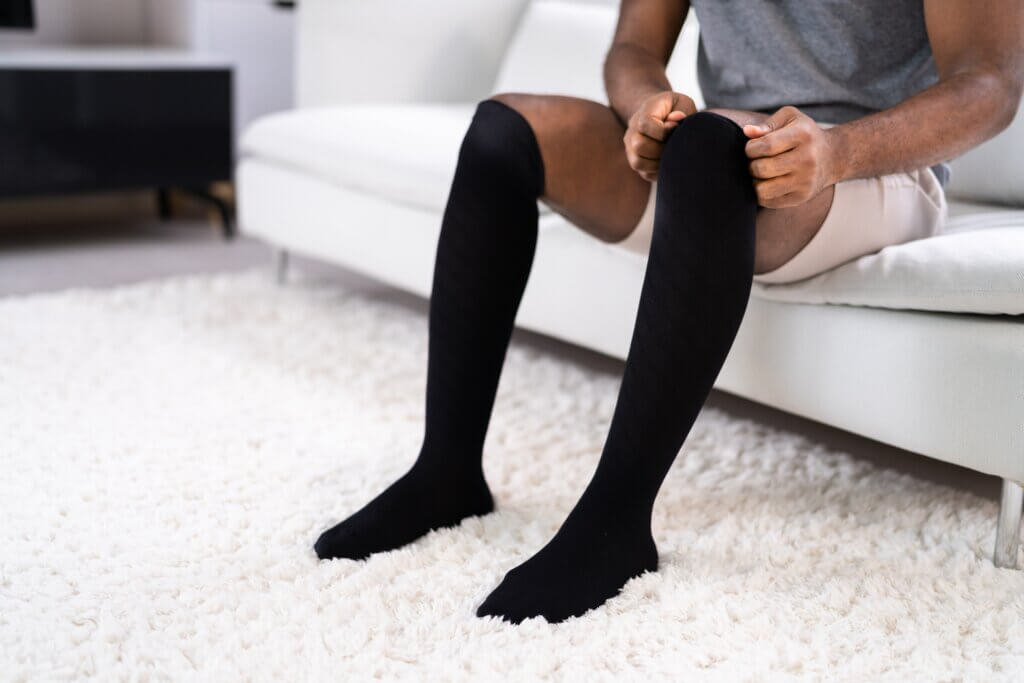6 Treatments for Fluid Retention

Fluid retention, also known as edema, occurs when excess fluid accumulates between tissues. This is a relatively common problem, and one that can easily go unnoticed. There are several treatments for fluid retention, and these are chosen based on the etiology of the condition.
It’s for this reason that a diagnostic process is irreplaceable when you need to deal with this condition. Certainly, edema can be a consequence of ingesting too much sodium, but it can also be a sign of impending lung disease. Our first piece of advice is to consult a specialist, but we’ve also compiled 6 treatments for fluid retention.
6 treatments for fluid retention
Most of the time the edema can resolve in a matter of days or weeks. Almost all of them are caused by benign triggers, although the presence of a medical condition should never be ruled out initially. Let’s see 6 treatments for fluid retention that scientists recommend.
1. Reduce salt intake
Researchers agree that excess salt intake can cause fluid retention. Sodium is a protagonist in the body’s water balance. When you consume more sodium than you should, the body can accumulate more water than it should expel under normal conditions. Sodium is an essential compound for the body, so you shouldn’t eliminate it completely.
According to the FDA, daily sodium intake shouldn’t exceed 2,300 milligrams per day. This is an average of one teaspoon of table salt spread over all meals. This not only includes the salt that you add to the food yourself when cooking, but also the salt that the products themselves already contain. Bread, sauces, canned beans and soups, sausages, and pastries are just a few items that you should reduce in your diet.
2. Wear compression socks

Experts recommend the use of compression stockings as part of treatment for fluid retention. Compression stockings control vascular tension, promote blood return, increase skeletal muscle pump, and improve lymphatic drainage. They are an alternative for the treatment of venous and lymphatic diseases, including edema or fluid retention.
Before buying one, we advise you to consult a professional. There are many types of compression stockings, both in their size and in the amount of pressure they exert. On average, to control fluid retention, stockings that produce a pressure of between 25 and 30 mmHg are suggested. Remember that its use can generate side effects, such as blisters, skin discoloration, discomfort and pain. For this reason, its use must be supervised.
3. Medication intake
Under certain circumstances, pharmacological treatments for fluid retention may be considered. As the specialists point out, the intake of diuretics is the best option, although in practice the medication is chosen according to the characteristics of each patient.
Diuretics, also known as water pills, work by helping the kidney eliminate excess sodium through the urine (although there are other mechanisms that work just as well).
4. Perform physical activity on a regular basis
Evidence indicates that during muscular exercises the external pressure on the veins is increased, which forces blood back to the heart. This in turn reduces hydrostatic pressure, one of the main triggers for edema. Any type of physical activity is welcome, although aerobic exercises are generally best.
Running, swimming, and biking are some of the best options. It is important to make exercise part of your daily routine, as it can also help control some conditions that often cause edema. Avoiding prolonged sitting or standing, and raise your legs while moving them a bit are also adjuncts to fluid retention treatments.
5. Quit smoking

Depending on the type of edema, the specialist may also recommend quitting smoking if you do. By itself, smoking doesn’t cause edema, but it can trigger conditions in the body that can lead to it. Smoking is also associated with several long-term complications, so reducing or even completely eliminating your intake will bring you only positive effects.
6. Control underlying diseases
There are many conditions that can cause edema. Venous insufficiency, lung diseases, heart failure, liver diseases, kidney diseases, thyroid disorders, and many more. These should be assessed as possible triggers, and if so, proceed to control them. The fluid retention treatments chosen at this point depend on the particular condition.
Timely medical evaluation is essential
As we have warned you, the mediation of a professional is essential when choosing the treatment for fluid retention. If you experience swelling in the lower extremities, don’t hesitate to seek medical assistance. The diagnostic process will find the cause, and once this is known, a personalized treatment can be implemented.
Fluid retention, also known as edema, occurs when excess fluid accumulates between tissues. This is a relatively common problem, and one that can easily go unnoticed. There are several treatments for fluid retention, and these are chosen based on the etiology of the condition.
It’s for this reason that a diagnostic process is irreplaceable when you need to deal with this condition. Certainly, edema can be a consequence of ingesting too much sodium, but it can also be a sign of impending lung disease. Our first piece of advice is to consult a specialist, but we’ve also compiled 6 treatments for fluid retention.
6 treatments for fluid retention
Most of the time the edema can resolve in a matter of days or weeks. Almost all of them are caused by benign triggers, although the presence of a medical condition should never be ruled out initially. Let’s see 6 treatments for fluid retention that scientists recommend.
1. Reduce salt intake
Researchers agree that excess salt intake can cause fluid retention. Sodium is a protagonist in the body’s water balance. When you consume more sodium than you should, the body can accumulate more water than it should expel under normal conditions. Sodium is an essential compound for the body, so you shouldn’t eliminate it completely.
According to the FDA, daily sodium intake shouldn’t exceed 2,300 milligrams per day. This is an average of one teaspoon of table salt spread over all meals. This not only includes the salt that you add to the food yourself when cooking, but also the salt that the products themselves already contain. Bread, sauces, canned beans and soups, sausages, and pastries are just a few items that you should reduce in your diet.
2. Wear compression socks

Experts recommend the use of compression stockings as part of treatment for fluid retention. Compression stockings control vascular tension, promote blood return, increase skeletal muscle pump, and improve lymphatic drainage. They are an alternative for the treatment of venous and lymphatic diseases, including edema or fluid retention.
Before buying one, we advise you to consult a professional. There are many types of compression stockings, both in their size and in the amount of pressure they exert. On average, to control fluid retention, stockings that produce a pressure of between 25 and 30 mmHg are suggested. Remember that its use can generate side effects, such as blisters, skin discoloration, discomfort and pain. For this reason, its use must be supervised.
3. Medication intake
Under certain circumstances, pharmacological treatments for fluid retention may be considered. As the specialists point out, the intake of diuretics is the best option, although in practice the medication is chosen according to the characteristics of each patient.
Diuretics, also known as water pills, work by helping the kidney eliminate excess sodium through the urine (although there are other mechanisms that work just as well).
4. Perform physical activity on a regular basis
Evidence indicates that during muscular exercises the external pressure on the veins is increased, which forces blood back to the heart. This in turn reduces hydrostatic pressure, one of the main triggers for edema. Any type of physical activity is welcome, although aerobic exercises are generally best.
Running, swimming, and biking are some of the best options. It is important to make exercise part of your daily routine, as it can also help control some conditions that often cause edema. Avoiding prolonged sitting or standing, and raise your legs while moving them a bit are also adjuncts to fluid retention treatments.
5. Quit smoking

Depending on the type of edema, the specialist may also recommend quitting smoking if you do. By itself, smoking doesn’t cause edema, but it can trigger conditions in the body that can lead to it. Smoking is also associated with several long-term complications, so reducing or even completely eliminating your intake will bring you only positive effects.
6. Control underlying diseases
There are many conditions that can cause edema. Venous insufficiency, lung diseases, heart failure, liver diseases, kidney diseases, thyroid disorders, and many more. These should be assessed as possible triggers, and if so, proceed to control them. The fluid retention treatments chosen at this point depend on the particular condition.
Timely medical evaluation is essential
As we have warned you, the mediation of a professional is essential when choosing the treatment for fluid retention. If you experience swelling in the lower extremities, don’t hesitate to seek medical assistance. The diagnostic process will find the cause, and once this is known, a personalized treatment can be implemented.
- Lee, Y., Kim, K., Kang, S., et al. (2020). Compression Stocking Length Effects on Oedema, Pain, and Satisfaction in Nursing Students: A Pilot Randomized Trial. Healthcare (Basel);8(2):149.
- O’Brien, J. G., Chennubhotla, S. A., Chennubhotla, R. V. (2005). Treatment of edema. Am Fam Physician;71(11):2111-7.
- Quilici, B. C., Gildo, C., de Godoy, J. M., Quilici, B. S., Augusto, C. R. (2009). Comparison of reduction of edema after rest and after muscle exercises in treatment of chronic venous insufficiency. Int Arch Med;2(1):18.
- Rakova, N., Kitada, K., Lerchl, K., Dahlmann, A., Birukov, A., Daub, S., Titze, J. (2017). Increased salt consumption induces body water conservation and decreases fluid intake. The Journal of clinical investigation;127(5):1932-1943.
Este texto se ofrece únicamente con propósitos informativos y no reemplaza la consulta con un profesional. Ante dudas, consulta a tu especialista.







